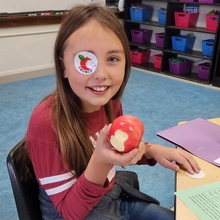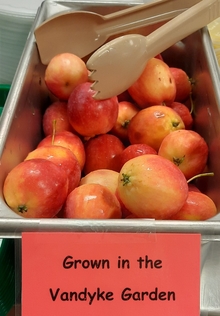From purple coleslaw to crabapples, farm-to-school harvests benefits for all
The first-grader in the lunch line at West Elementary School in Hutchinson gave the kitchen staff the side-eye. “Purple coleslaw?” she exclaimed.
The Hutchinson, Litchfield and Dassel-Cokato districts buy produce from local growers. This month there was a lot of purple cabbage.
Kitchen staffer Wendy Shafer thought if the girl tried it, she might like it and even influence others at her table. So she told her about the farm it came from, the nutrients in purple produce and why the creamy dressing atop the purple cabbage had turned pink.
The girl returned to Shafer later with an empty tray. “I loved it,” she said. Not everyone at her table felt the same, but they all tried it thanks to Shafer’s encouragement.
“Students move in flocks,” says Aimee Haag, the farm-to-school liaison for the Hutchinson, Litchfield and Dassel-Cokato districts that share food services and resources. “We work hard to get the lunch and snacks all figured out, but we are really missing the boat if we don’t connect with the student like Wendy did.”
Local foods and learning
Farm-to-school is the catch-all term for efforts that include serving local food, integrating knowledge about food and horticulture into lesson plans, and often planting a garden with students on school grounds.
“University of Minnesota Extension plays a connecting role for schools and farmers, as well as with nutrition education in the classroom and ways to make it easier to prepare fresh food,” says Jackie Billhymer, Extension statewide farm-to-institution coordinator.
“We have access to talented growers here,” Haag says, noting the example of Laura Frerichs and Adam Cullip. Their farm, Loon Organics, has worked closely with Extension regarding on-farm food safety practices.
Schoolyard gardens
Jodi Nordlund is an Extension SNAP-Ed* educator who lives in Grand Rapids and works in Itasca and Aitkin counties.
Nordlund has been busy working with youth to harvest the Vandyke Elementary School garden, which has also become a bit of an orchard with the apple and crabapple trees.
“Last week the kids dug potatoes and picked broccoli, herbs and apples,” says Nordlund. “They were so proud.” Principal Sue Hoeft joined the group to harvest and deliver the produce to the cafeteria, along with two bouquets of zinnia flowers.
Carol Barnett is the food service coordinator for the Greenway School District, which includes Vandyke Elementary. She places many orders from the Grand Rapids Farmers Market, but the lettuce this month will come from the Vandyke garden. So will the parsley and basil that go into the spaghetti.
“I’m busy enough with the food planning, so the education part is all Jodi,” Barnett says. “She works with the kids and the garden, keeps the parents up to date and connects with the community."
Special education teacher Jennifer Green agrees that the garden provides huge benefits. “The kids I work with all know when Jodi is coming for ‘garden club’ and are on their best behavior,” she says.
Minnesota Harvest of the Month
Extension, along with the Minnesota Department of Agriculture and the Minnesota Department of Education, created a Minnesota Harvest of the Month program as one way to implement farm-to-school.
Schools participating in Harvest of the Month can order free printed materials like recipe cards, posters and signs. They get access to lesson plans and fun activities, such as taste-testing with stickers for trying a food. The idea is that busy school staff don’t have to reinvent the wheel in order for their students to benefit.
Nordlund co-led a pilot Harvest of the Month program last year at Vandyke Elementary and is back this month. October’s featured harvest is apples. One thing Nordlund will do with students is taste-test 12 varieties of apples. “They can’t just say they like or don’t like one – they find their words to say it’s mushy, bland, crunchy or sweet,” she says.
“Being part of the pilot project meant we learned what works and what doesn’t,” says Barnett. Wild rice was a winner. Raw poultry was too much work to prepare and cook in her kitchens, but she will order local eggs this year.
“It is more work when the food enters the cafeteria in a large wheelbarrow pushed by students or from a farm,” adds Barnett. “But it makes the kids feel really connected to their community here, and I believe in that.”
*Supplemental Nutrition Assistance Program Education





